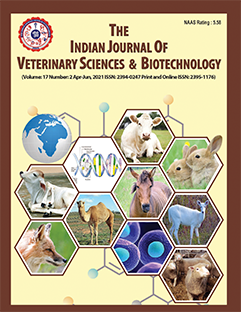Subacute Canine Monocytic Ehrlichiosis in a Two Month Old Siberian-Husky Puppy – Diagnosis and Therapeutic Management
DOI:
https://doi.org/10.48165/ijvsbt.21.5.40Keywords:
anorexia, ocular discharge, petechiae, epistaxis, pale mucosaeAbstract
Canine monocytic ehrlichiosis (CME) caused by E. canis is most pathogenic and transmitted by the tick vector Riphicephalus sanguineus with non-regenerative anaemia and thrombocytopenia as common haematological abnormalities (Piratae et al., 2019). The disease may progress as acute, subacute and chronic, and in acute form, fever, anorexia, ocular discharge, petechiae, epistaxis, pale mucosae, bleeding signs, lymphadenopathy, and neurological signs may be observed (Waner and Harrus, 2013). In chronic phase, severe pancytopenia due to bone marrow hypoplasia is characteristic, which leads to severe leukopenia, anaemia, and thrombocytopenia resulting in death (Angkanaporn et al., 2022). Usually, the detection of E. canis (morulae) in dogs by conventional microscopy becomes very difficult owing to the low parasitaemia (Singh et al., 2021) and thus failure of detection in an early stage leads to chronic myelosuppressive form, which is often fatal. Siberian husky is the breed highly susceptible to CME, however, the incidence in this breed is rarely reported in India (Singh et al., 2021). This study reports an early diagnosis of sub-acute ehrlichiosis in a Siberian husky puppy and it’s successful therapeutic management.
Downloads
References
Angkanaporn, K., Sanguanwai, J., Baiyokvichit, T.O., Vorrachotvarittorn, P., Wongsompong, M., & Sukhumavasi, W. (2022). Retrospective analysis of canine monocytic ehrlichiosis in Thailand with emphasis on hematological and ultrasonographic changes. Veterinary World, 15(1), 1–9.
Asawapattanakul, T., Pintapagung, T., Piratae, S., Juntautsa, S., & Chancharoen, P. (2021). Erythrocyte sedimentation rate, C-reactive protein, and interleukin-6 as inflammatory biomarkers in dogs naturally infected with Ehrlichia canis. Veterinary World, 14(9), 2325–2331.
Checa, R., Peteiro, L., Perez-Hernando, B., Morena, M.D., Cano, L., Lopez-Suarez, P., Barrera, J.P., Estevez-Sanchez, E., Sarquis, J., Fernandez-Cebrian, B., Montoya, A., & Miro, G. (2024). High serological and molecular prevalence of Ehrlichia canis and other vector-borne pathogens in dogs from Boa Vista Island, Cape Verde. Parasites & Vectors, 17, 374.
Geromichalou, A., & Faixova, Z. (2017). Haemato-pathological changes in dogs affected with Ehrlichia canis in Lesvos. Folia Veterinaria, 61, 44–49.
Kalaivanan, M., Saravanan, S., Palanivel, K.M., & Ponnudurai, G. (2020). Identification of Ehrlichia canis by PCR with phylogenetic analysis in dogs from south India. The Haryana Veterinarian, 59, 79–82.
Kottadamane, M.R., Dhaliwal, P.S., Singla, L.D., Bansal, B.K., & Uppal, S.K. (2017). Clinical and hemato-biochemical response in canine monocytic ehrlichiosis seropositive dogs of Punjab. Veterinary World, 10(2), 255.
Mylonakis, M.E., & Theodorou, K.N. (2017). Canine monocytic ehrlichiosis: An update on diagnosis and treatment. Acta Veterinaria Scandinavica, 67, 299–317.
Piratae, S., Senawong, P., Chalermchat, P., Harnarsa, W., & Sae Chue, B. (2019). Molecular evidence of Ehrlichia canis and Anaplasma platys and the association of infections with hematological responses in naturally infected dogs in Kalasin, Thailand. Veterinary World, 12(1), 131–135.
Sainz, A., Roura, X., Miro, G., Estrada-Pena, A., Kohn, B., Harrus, S., & Solano-Gallego, L. (2015). Guideline for veterinary practitioners on canine ehrlichiosis and anaplasmosis in Europe. Parasites & Vectors, 8, 75.
Singh, J., Singh, R.S., Singh, H., Gupta, D.K., & Randhawa, S.S. (2021). Clinical and haemato-biochemical observations in dogs naturally infected with canine monocytic ehrlichiosis. Exploratory Animal and Medical Research, 11(2), 214–219.
Singh, A., Srivastava, M.K., & Gupta, K.K. (2021a). Ultrasonographic assessment of important abdominal organs in a dog naturally infected with Ehrlichia canis. Veterinary Practitioner, 22, 64–66.
Waner, T., & Harrus, S. (2013). Canine monocytic ehrlichiosis - From pathology to clinical manifestations. Israel Journal of Veterinary Medicine, 68(1), 12–18.
Downloads
Published
Issue
Section
License
Copyright (c) 2025 Indian Journal of Veterinary Sciences and Biotechnology

This work is licensed under a Creative Commons Attribution-NonCommercial-NoDerivatives 4.0 International License.




